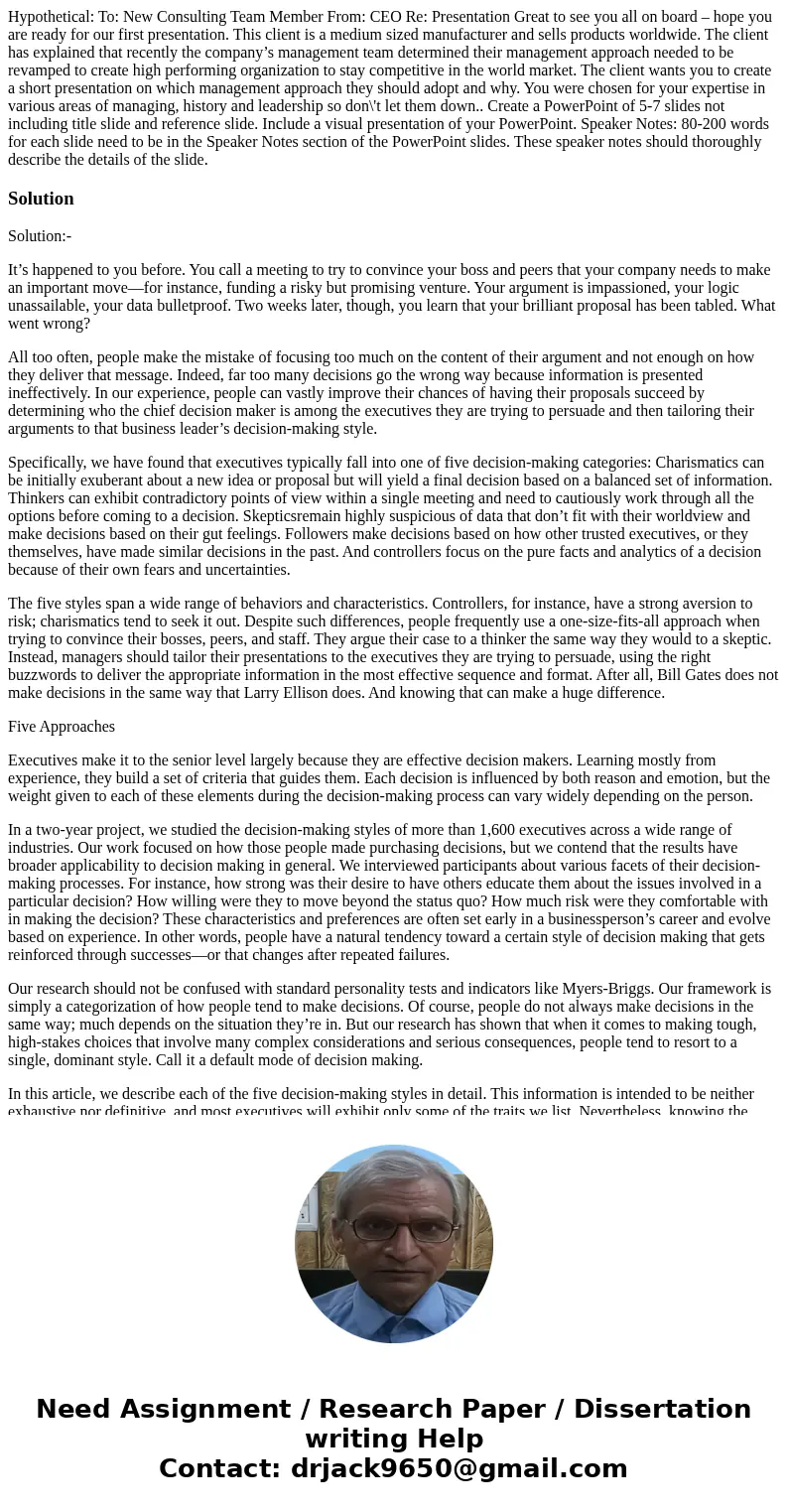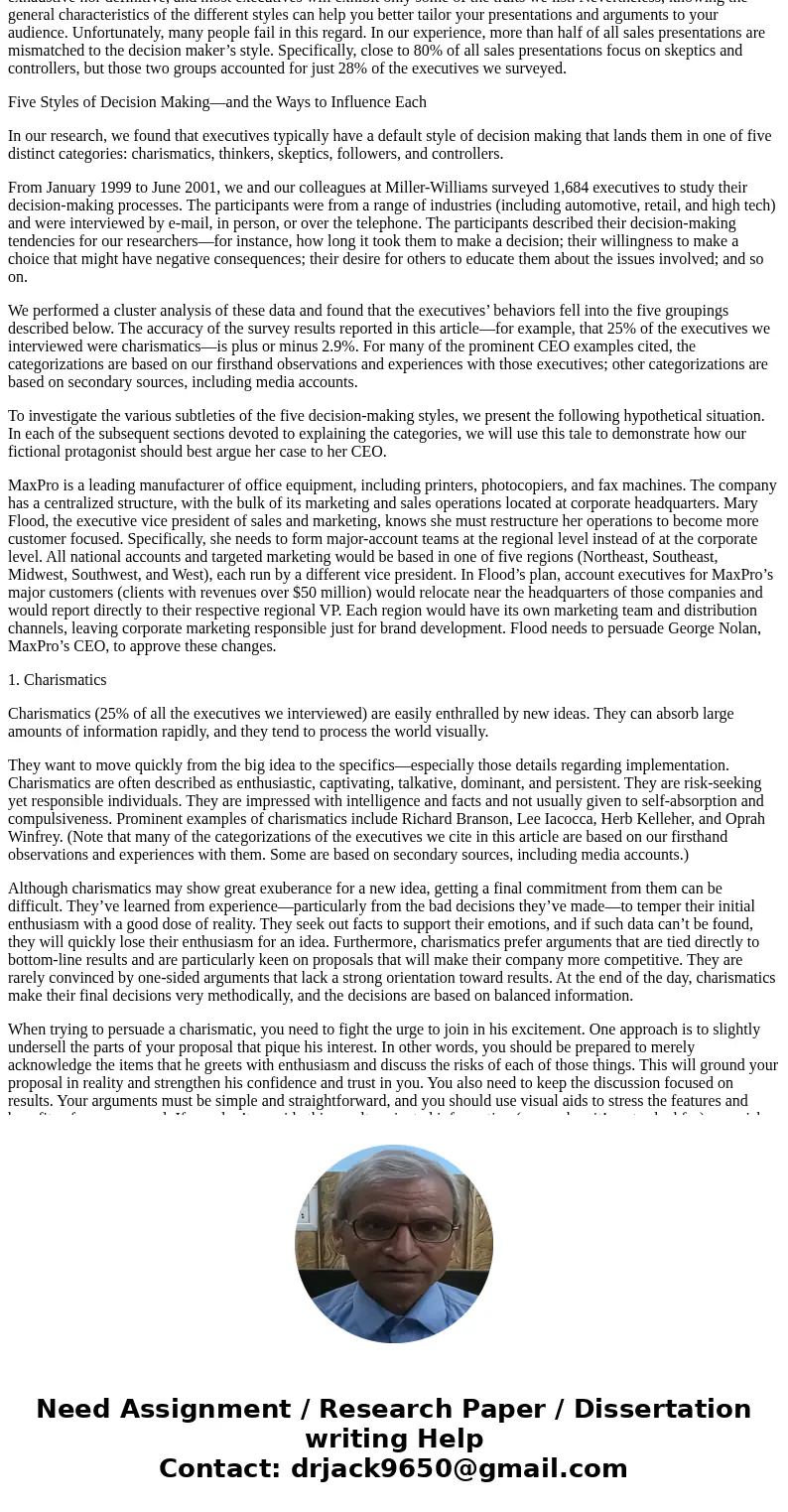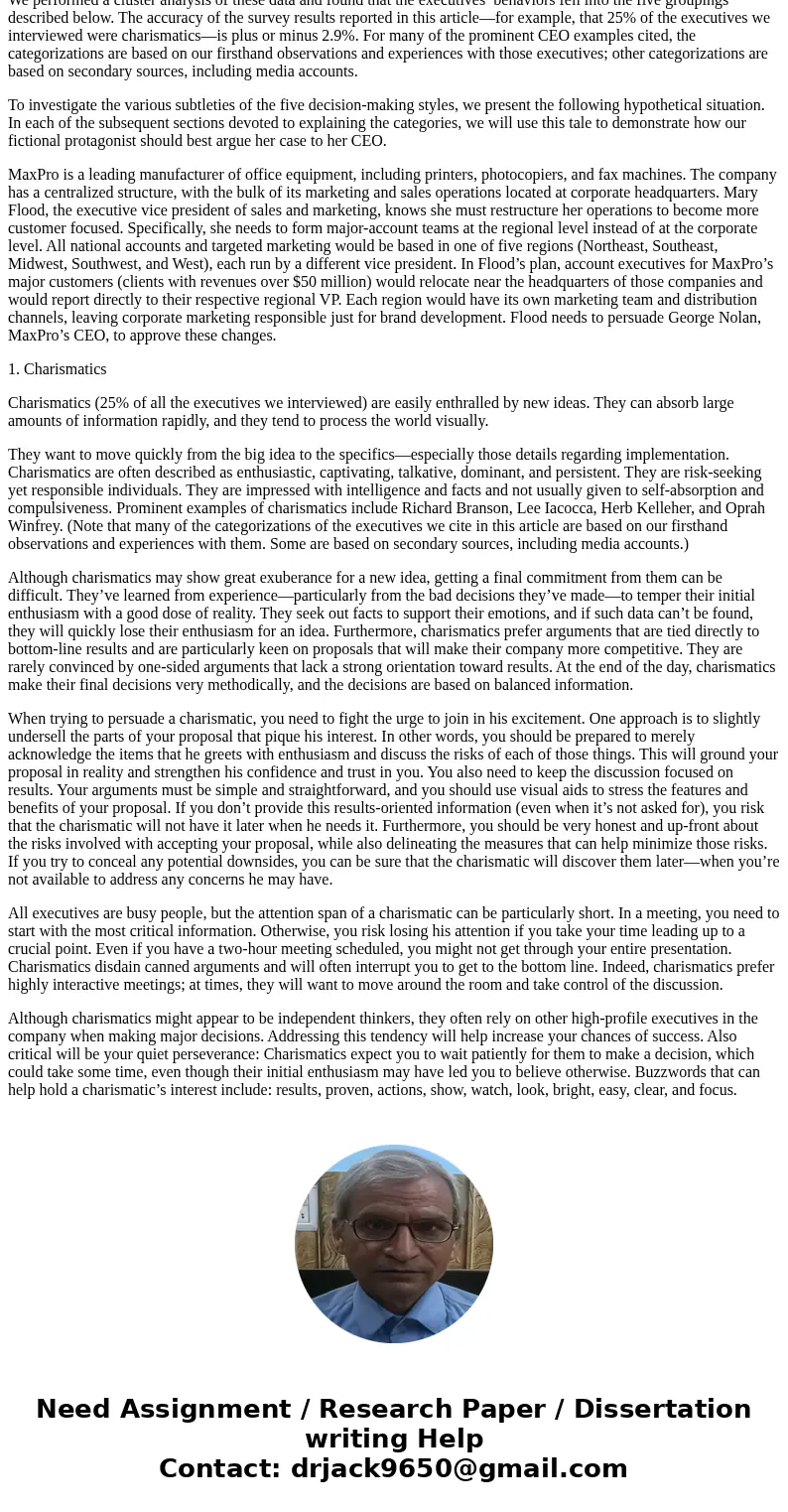Hypothetical To New Consulting Team Member From CEO Re Prese
Hypothetical: To: New Consulting Team Member From: CEO Re: Presentation Great to see you all on board – hope you are ready for our first presentation. This client is a medium sized manufacturer and sells products worldwide. The client has explained that recently the company’s management team determined their management approach needed to be revamped to create high performing organization to stay competitive in the world market. The client wants you to create a short presentation on which management approach they should adopt and why. You were chosen for your expertise in various areas of managing, history and leadership so don\'t let them down.. Create a PowerPoint of 5-7 slides not including title slide and reference slide. Include a visual presentation of your PowerPoint. Speaker Notes: 80-200 words for each slide need to be in the Speaker Notes section of the PowerPoint slides. These speaker notes should thoroughly describe the details of the slide.
Solution
Solution:-
It’s happened to you before. You call a meeting to try to convince your boss and peers that your company needs to make an important move—for instance, funding a risky but promising venture. Your argument is impassioned, your logic unassailable, your data bulletproof. Two weeks later, though, you learn that your brilliant proposal has been tabled. What went wrong?
All too often, people make the mistake of focusing too much on the content of their argument and not enough on how they deliver that message. Indeed, far too many decisions go the wrong way because information is presented ineffectively. In our experience, people can vastly improve their chances of having their proposals succeed by determining who the chief decision maker is among the executives they are trying to persuade and then tailoring their arguments to that business leader’s decision-making style.
Specifically, we have found that executives typically fall into one of five decision-making categories: Charismatics can be initially exuberant about a new idea or proposal but will yield a final decision based on a balanced set of information. Thinkers can exhibit contradictory points of view within a single meeting and need to cautiously work through all the options before coming to a decision. Skepticsremain highly suspicious of data that don’t fit with their worldview and make decisions based on their gut feelings. Followers make decisions based on how other trusted executives, or they themselves, have made similar decisions in the past. And controllers focus on the pure facts and analytics of a decision because of their own fears and uncertainties.
The five styles span a wide range of behaviors and characteristics. Controllers, for instance, have a strong aversion to risk; charismatics tend to seek it out. Despite such differences, people frequently use a one-size-fits-all approach when trying to convince their bosses, peers, and staff. They argue their case to a thinker the same way they would to a skeptic. Instead, managers should tailor their presentations to the executives they are trying to persuade, using the right buzzwords to deliver the appropriate information in the most effective sequence and format. After all, Bill Gates does not make decisions in the same way that Larry Ellison does. And knowing that can make a huge difference.
Five Approaches
Executives make it to the senior level largely because they are effective decision makers. Learning mostly from experience, they build a set of criteria that guides them. Each decision is influenced by both reason and emotion, but the weight given to each of these elements during the decision-making process can vary widely depending on the person.
In a two-year project, we studied the decision-making styles of more than 1,600 executives across a wide range of industries. Our work focused on how those people made purchasing decisions, but we contend that the results have broader applicability to decision making in general. We interviewed participants about various facets of their decision-making processes. For instance, how strong was their desire to have others educate them about the issues involved in a particular decision? How willing were they to move beyond the status quo? How much risk were they comfortable with in making the decision? These characteristics and preferences are often set early in a businessperson’s career and evolve based on experience. In other words, people have a natural tendency toward a certain style of decision making that gets reinforced through successes—or that changes after repeated failures.
Our research should not be confused with standard personality tests and indicators like Myers-Briggs. Our framework is simply a categorization of how people tend to make decisions. Of course, people do not always make decisions in the same way; much depends on the situation they’re in. But our research has shown that when it comes to making tough, high-stakes choices that involve many complex considerations and serious consequences, people tend to resort to a single, dominant style. Call it a default mode of decision making.
In this article, we describe each of the five decision-making styles in detail. This information is intended to be neither exhaustive nor definitive, and most executives will exhibit only some of the traits we list. Nevertheless, knowing the general characteristics of the different styles can help you better tailor your presentations and arguments to your audience. Unfortunately, many people fail in this regard. In our experience, more than half of all sales presentations are mismatched to the decision maker’s style. Specifically, close to 80% of all sales presentations focus on skeptics and controllers, but those two groups accounted for just 28% of the executives we surveyed.
Five Styles of Decision Making—and the Ways to Influence Each
In our research, we found that executives typically have a default style of decision making that lands them in one of five distinct categories: charismatics, thinkers, skeptics, followers, and controllers.
From January 1999 to June 2001, we and our colleagues at Miller-Williams surveyed 1,684 executives to study their decision-making processes. The participants were from a range of industries (including automotive, retail, and high tech) and were interviewed by e-mail, in person, or over the telephone. The participants described their decision-making tendencies for our researchers—for instance, how long it took them to make a decision; their willingness to make a choice that might have negative consequences; their desire for others to educate them about the issues involved; and so on.
We performed a cluster analysis of these data and found that the executives’ behaviors fell into the five groupings described below. The accuracy of the survey results reported in this article—for example, that 25% of the executives we interviewed were charismatics—is plus or minus 2.9%. For many of the prominent CEO examples cited, the categorizations are based on our firsthand observations and experiences with those executives; other categorizations are based on secondary sources, including media accounts.
To investigate the various subtleties of the five decision-making styles, we present the following hypothetical situation. In each of the subsequent sections devoted to explaining the categories, we will use this tale to demonstrate how our fictional protagonist should best argue her case to her CEO.
MaxPro is a leading manufacturer of office equipment, including printers, photocopiers, and fax machines. The company has a centralized structure, with the bulk of its marketing and sales operations located at corporate headquarters. Mary Flood, the executive vice president of sales and marketing, knows she must restructure her operations to become more customer focused. Specifically, she needs to form major-account teams at the regional level instead of at the corporate level. All national accounts and targeted marketing would be based in one of five regions (Northeast, Southeast, Midwest, Southwest, and West), each run by a different vice president. In Flood’s plan, account executives for MaxPro’s major customers (clients with revenues over $50 million) would relocate near the headquarters of those companies and would report directly to their respective regional VP. Each region would have its own marketing team and distribution channels, leaving corporate marketing responsible just for brand development. Flood needs to persuade George Nolan, MaxPro’s CEO, to approve these changes.
1. Charismatics
Charismatics (25% of all the executives we interviewed) are easily enthralled by new ideas. They can absorb large amounts of information rapidly, and they tend to process the world visually.
They want to move quickly from the big idea to the specifics—especially those details regarding implementation. Charismatics are often described as enthusiastic, captivating, talkative, dominant, and persistent. They are risk-seeking yet responsible individuals. They are impressed with intelligence and facts and not usually given to self-absorption and compulsiveness. Prominent examples of charismatics include Richard Branson, Lee Iacocca, Herb Kelleher, and Oprah Winfrey. (Note that many of the categorizations of the executives we cite in this article are based on our firsthand observations and experiences with them. Some are based on secondary sources, including media accounts.)
Although charismatics may show great exuberance for a new idea, getting a final commitment from them can be difficult. They’ve learned from experience—particularly from the bad decisions they’ve made—to temper their initial enthusiasm with a good dose of reality. They seek out facts to support their emotions, and if such data can’t be found, they will quickly lose their enthusiasm for an idea. Furthermore, charismatics prefer arguments that are tied directly to bottom-line results and are particularly keen on proposals that will make their company more competitive. They are rarely convinced by one-sided arguments that lack a strong orientation toward results. At the end of the day, charismatics make their final decisions very methodically, and the decisions are based on balanced information.
When trying to persuade a charismatic, you need to fight the urge to join in his excitement. One approach is to slightly undersell the parts of your proposal that pique his interest. In other words, you should be prepared to merely acknowledge the items that he greets with enthusiasm and discuss the risks of each of those things. This will ground your proposal in reality and strengthen his confidence and trust in you. You also need to keep the discussion focused on results. Your arguments must be simple and straightforward, and you should use visual aids to stress the features and benefits of your proposal. If you don’t provide this results-oriented information (even when it’s not asked for), you risk that the charismatic will not have it later when he needs it. Furthermore, you should be very honest and up-front about the risks involved with accepting your proposal, while also delineating the measures that can help minimize those risks. If you try to conceal any potential downsides, you can be sure that the charismatic will discover them later—when you’re not available to address any concerns he may have.
All executives are busy people, but the attention span of a charismatic can be particularly short. In a meeting, you need to start with the most critical information. Otherwise, you risk losing his attention if you take your time leading up to a crucial point. Even if you have a two-hour meeting scheduled, you might not get through your entire presentation. Charismatics disdain canned arguments and will often interrupt you to get to the bottom line. Indeed, charismatics prefer highly interactive meetings; at times, they will want to move around the room and take control of the discussion.
Although charismatics might appear to be independent thinkers, they often rely on other high-profile executives in the company when making major decisions. Addressing this tendency will help increase your chances of success. Also critical will be your quiet perseverance: Charismatics expect you to wait patiently for them to make a decision, which could take some time, even though their initial enthusiasm may have led you to believe otherwise. Buzzwords that can help hold a charismatic’s interest include: results, proven, actions, show, watch, look, bright, easy, clear, and focus.



 Homework Sourse
Homework Sourse